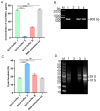Development of a Paper-Based Microfluidic Chip for Point-of-Care Detection of PEDV
- PMID: 40431520
- PMCID: PMC12115601
- DOI: 10.3390/vetsci12050427
Development of a Paper-Based Microfluidic Chip for Point-of-Care Detection of PEDV
Abstract
PEDV poses a significant threat to the global swine industry, necessitating rapid and accurate diagnostic methods for effective disease management. In this study, we developed a foldable, easy-to-use paper-based microfluidic analytical device (μPAD) for on-site detection of PEDV. The device seamlessly integrates paper-based nucleic acid enrichment, LAMP reaction, and visual lateral flow detection into a single platform. Key parameters, including nucleic acid extraction protocols, chromatographic channel configurations, colorimetric indicators, and reaction temperature and duration, were systematically optimized. The resulting LAMP-μPAD assay detects PEDV within 30 min at 60 °C, achieving a limit of detection of 4.82 × 102 copies/μL with no cross-reactivity against other viruses. When evaluated against RT-PCR using clinical specimens, the assay demonstrated a specificity of 100%, a sensitivity of 95.3%, and an overall concordance of 98.5%. This paper-based sensor offers a promising alternative for the rapid, on-site detection of PEDV and other highly transmissible pathogens.
Keywords: loop-mediated isothermal amplification; paper-based microfluidic analytical device; point-of-care detection; porcine epidemic diarrhea virus.
Conflict of interest statement
The authors declare no conflicts of interest.
Figures










Similar articles
-
Microfluidic-RT-LAMP chip for the point-of-care detection of emerging and re-emerging enteric coronaviruses in swine.Anal Chim Acta. 2020 Aug 15;1125:57-65. doi: 10.1016/j.aca.2020.05.034. Epub 2020 May 19. Anal Chim Acta. 2020. PMID: 32674781 Free PMC article.
-
A portable, 3D printed, microfluidic device for multiplexed, real time, molecular detection of the porcine epidemic diarrhea virus, transmissible gastroenteritis virus, and porcine deltacoronavirus at the point of need.Lab Chip. 2021 Mar 21;21(6):1118-1130. doi: 10.1039/d0lc01229g. Epub 2021 Feb 2. Lab Chip. 2021. PMID: 33527920 Free PMC article.
-
Development of a triplex RT-RAA-LFA assay for the rapid differential diagnosis of porcine epidemic diarrhea virus, porcine deltacoronavirus and transmissible gastroenteritis virus.Microb Pathog. 2024 Oct;195:106885. doi: 10.1016/j.micpath.2024.106885. Epub 2024 Aug 24. Microb Pathog. 2024. PMID: 39182857
-
An isothermal nucleic acid amplification-based enzymatic recombinase amplification method for dual detection of porcine epidemic diarrhea virus and porcine rotavirus A.Virology. 2024 Jun;594:110062. doi: 10.1016/j.virol.2024.110062. Epub 2024 Mar 20. Virology. 2024. PMID: 38522136 Review.
-
Current State of Molecular and Serological Methods for Detection of Porcine Epidemic Diarrhea Virus.Pathogens. 2022 Sep 21;11(10):1074. doi: 10.3390/pathogens11101074. Pathogens. 2022. PMID: 36297131 Free PMC article. Review.
References
Grants and funding
LinkOut - more resources
Full Text Sources

